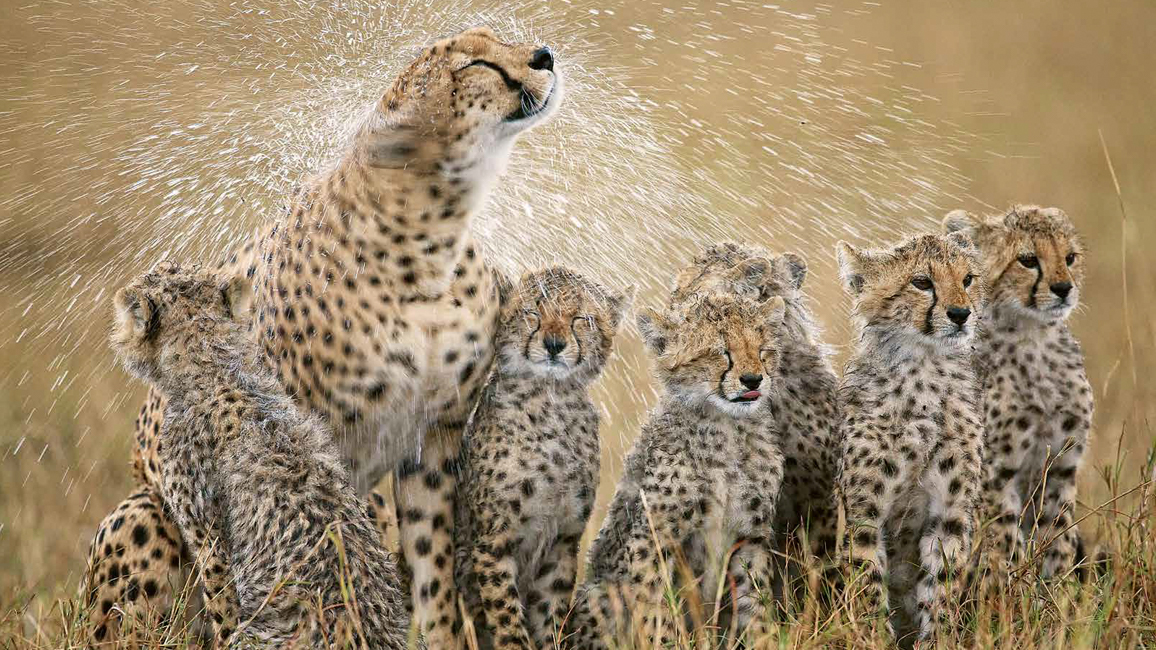
Rainy-Day Animals
By Hannah SchardtWith a shake-shake-shake, this mother cheetah dries her rain-drenched fur—giving her cubs an accidental shower!
Just about everywhere there are animals, there is rain. Some animals love it—or at least don’t mind it. But for many—including people—rain can be a bother. We have umbrellas and rain boots to keep us dry. Keep reading to find out how wild animals deal with downpours.
BLOCK IT OUT
Being caught in the rain isn’t just annoying. For some animals, getting soaked can be downright dangerous. Warm-blooded animals, including mammals and birds, need to keep their body temperatures steady. When rain soaks them to the skin, they may become too cold to survive.
Luckily, they have coverings—either fur or feathers—that repel, or push away, water. By the time they are adults, most mammals have thick, stiff, slick fur. When raindrops fall on that fur, they roll right off—at least for a while.
Birds also have a cool trick for keeping dry: They dip their bills into oil glands near their tails. Then they preen, rubbing the oil over their feathers. The oil helps waterproof the feathers. So when rain comes, the birds are able to wait it out inside their feathery “raincoats.”
In a big storm, birds and mammals don’t rely only on their feathered or furry coats. An impala, for example, may flatten its ears to keep water out. A hippo may close its nostrils. And both birds and mammals can easily shed the water with a quick shake.
The hippopotamus (above right) stands still and waits out a sudden storm. A thick layer of fat—not fur—keeps hippos warm even in pouring rain.
The oily feathers on the black vultures (above left) help keep rain away from the birds’ skin. And thick fur lets a long-tailed macaque (muh-KAK) ignore heavy rain (photo in circle).
Falling raindrops can drown out the sound of a sneaky lion or other predator. So the impalas (top left photo) huddle together out in the open. This gives them a clear view of approaching threats.
TAKE COVER
Oily feathers and thick fur make pretty good raincoats. But many animals would still rather not feel raindrops falling on their heads. So they find other ways of keeping dry.
Butterflies and many other insects can’t fly in the rain. (Imagine being pelted by a bowling ball. That’s what a single raindrop feels like to a butterfly!) So they ride out storms by clinging to the undersides of leaves.
A fox or wolf may find a cozy spot under a leafy shrub or in a cave. Mice or other small rodents might cuddle up together inside a hollow log.
But what’s an animal to do when it needs to be on the go on a rainy day? Some just get wet, of course. But others do what we do: Use an umbrella or a rain hat!
Orangutans make “hats” out of big leaves to protect their heads during downpours. (In zoos, they sometimes use cloth bags.) And a squirrel may flop its fluffy tail over its back and head. Sure, the tail gets wet, but the most important parts of the body stay nice and dry.
Brrrr! A slushy mix of rain and snow drove this Eurasian lynx (above) under a rocky ledge. A furry coat keeps it warm, but that works only when the fur stays dry!
Delicate insect wings don’t work when wet. So this dragonfly (top right photo) waits out a storm under a leaf. The squirrel (photo in circle) isn’t bothered by a little rain—not when its tail makes a perfectly good umbrella!
The black-legged kittiwake (top left photo) uses her body to shelter her chicks from the rain. The chicks have feathers that are fuzzy, not slick. So they rely on Mom to keep them dry.
MAKE A SPLASH!
Some animals ignore the rain. Others try to avoid it. And then there are those that love the wet stuff. For these animals, a rainy day brings a chance to mate, a fun mud bath, or a quick trip.
Have you noticed that earthworms pop out of the ground during rainstorms? (You probably try not to squish them when you are walking along the sidewalk.) Earthworms spend most of their time underground because their bodies dry out in the air. But when rain is falling, they slither to the surface. Up there, they can travel much faster than underground while still keeping their bodies moist. Of course, being out in the open is risky for juicy worms: Robins and other birds may pluck them up for a delicious “tweet.”
Of all the rain-loving animals, the champion just might be the spadefoot toad. It lives in dry places and spends most of its life alone underground to keep its body moist. But when the rainy season starts, the toad party gets going. Spurred by the sound of thunder or rain, all the spadefoots in the area dig their way out to find each other. They quickly mate and lay eggs. Then they dig back into the ground to rest—and wait for the next big rain.
The elephant family (above) wallows happily as a rainstorm turns a patch of dirt into an ooey, gooey mud puddle. Mud helps elephants shed pesky pests.
An earthworm (photo in circle) pokes out of the ground after a rainfall, and a spadefoot toad enjoys a refreshing soak after having spent several months underground.
Rain, rain go away? No way! Rain, we hope you’ll stay!
“It’s Raining!” originally appeared in the April 2014 issue of Ranger Rick magazine.
(Click on each image above for a closer view of the story.)




















